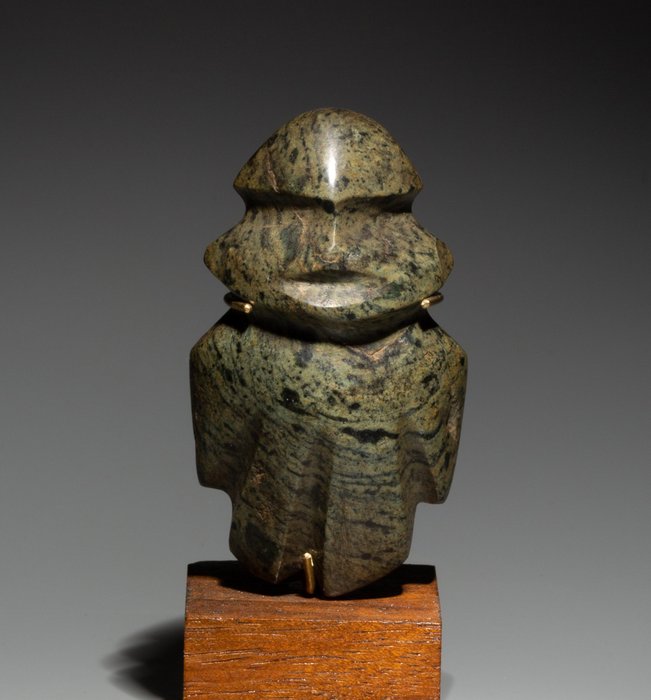
Neolittisk Stein Spydspiss. ca. 1000 f.Kr. 18,5 cm H.
Nr. 82683135

Nr. 82683135

Anthropomorphic Figure
- Intact -
- huge figure -
CULTURE: Mezcala, Estado de Guerrero, Mexico
PERIOD: 200 BC – 500 AD
MATERIAL: Stone
SIZE: Height 7,5 cm without stand.
PROVENANCE: Spanish Private Collection, Ms. M. G., formed in the 1970's
CONDITION: Intact.
DESCRIPTION:
During the Mesoamerican Pre-Classic era, a great tradition grew up of making small stone objects in the zone of Guerrero as well as along the Mexican Pacific coast. Three well differentiated, but related styles can be identified: Mezcala, Chontal and Sultepec.
The Mezcala style was defined in the decade of the 1960s, documented by stone pieces made from calcite, diorite, andesite, meta-diorite, serpentinite, porphyry, among other types of stone. These are thought to originate in the basin of the River Mezcala, in the state of Guerrero. They are characterized by their schematic form and faintly suggested features, and include figurines, masks and small temples among the most common types, along with jaguars, frogs, monkeys and birds, or tools like axes, chisels, burins and buffers.
Using only rudimentary tools, the stoneware artisans of Guerrero created objects that represented anthropomorphic and zoomorphic figures or architectural structures, reducing the forms to their purest essence. As the rendering of these pieces is defined by their simplicity and their strong geometrical forms, they connect closely with modern aesthetic sensibilities.
BIBLIOGRPHY:
- GAY, Carlo T. Mezcala Stone Sculpture: the human figure. The Museum of Primitive Art. Nueva York. 1967.
- REYNA-ROBLES, Rosa María. La Cultura Arqueologica Mezcala. Instituto Nacional de Antropologia e Historia. 2006.
- El arte Mezcala. Gobierno Constitucional del Estado de Guerrero. México. 1993.
- El estado de Guerrero, un estado por descubrir. Revista Arqueología Mexicana. Vol. 24, nov-dic 2006.
Notes:
- The piece includes authenticity certificate.
- The piece includes Spanish Export License (Passport for European Union).
- According to Spanish legislation, items sent outside the European Union are subject to export taxes and will be added to the invoice, at the buyer's expense. These export fees are fixed on the final auction price and the tax rate is not applied directly on the total value of the item to be exported, but rather the different percentages by sections are applied to it:
- Up to 6,000 euros: 5%.
- From 6.001 to 60.000 euros: 10%.
This export permit application process can take between 1-2 months maximum.
- The seller guarantees that he acquired this piece according to all national and international laws related to the ownership of cultural property. Provenance statement seen by Catawiki.
Hvordan kjøpe på Catawiki
1. Oppdag noe spesielt
2. Legg inn det høyeste budet
3. Å gjøre en sikker betaling